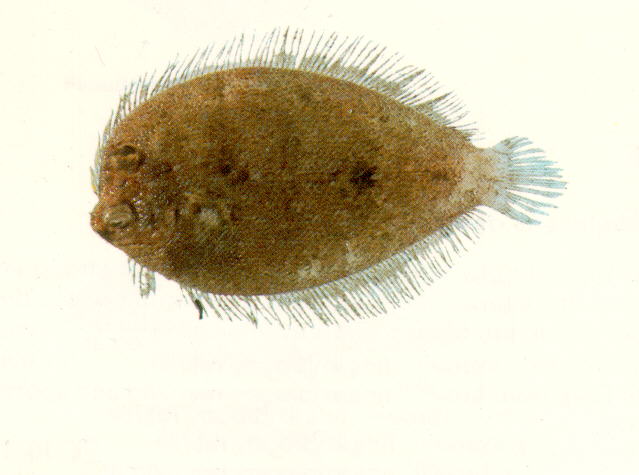| Bothidae (Lefteye flounders) |
| 18 cm TL (male/unsexed) |
|
demersal; marine; depth range 13 - 60 m |
| Indo-West Pacific: Bay of Bengal, northwestern Australia, South China Sea, China, Taiwan, Japan, Viet Nam, and Aru Islands, Indonesia. |
|
Dorsal soft rays (total): 84-92; Anal soft rays: 63-74. Ground colour on eyed side brownish grey, with darker spots and blotches. Fins paler than body, dorsal and anal fins with small dark spots, caudal fin with 2 distinct dark bands. Males with small dark spots in anterior part of interorbital region. Blind side whitish in females. Males with distinct bluish black pyriform colour pattern on blind side. Body ovoid, its depth 1.7 to 2 times in SL. Head small, snout shorter than eye, profile steep anterior to interorbital area. Head length 3.3 to 4.5 times in SL. Interorbital region broad and concave, wider in males than females in specimens greater than about 6 cm SL. Males with a rostral spine and 1 to 3 low bony bumps around orbits. Both eyes on left side of head, front margin of upper eye slightly behind front margin of lower eye. Both eyes in males larger than about 6 cm SL with a flap on posterior area. Mouth small, reaching to or slightly beyond anterior margin of lower eye, length of upper jaw 3.1 to 4.3 times in head length. Teeth in upper jaw biserial, teeth of outer row more widely spaced than teeth of inner row; teeth in lower jaw uniserial. Gill rakers short and pointed. Scales on eyed side with long ctenii. Pectoral fin on eyed side with 11 to 14 rays, its length 1.3 to 1.6 times in head length in both sexes. Pectoral fin on blind side with 9 to 12 rays (Ref 42535). |
| Lives on mud bottoms and feeds on bottom-living animals (Ref. 9824). Sexually dimorphic characters develop at about 6 cm SL (Ref. 9824). |
|
Least Concern (LC); Date assessed: 11 November 2019 Ref. (130435)
|
| harmless |
Source and more info: www.fishbase.org. For personal, classroom, and other internal use only. Not for publication.

